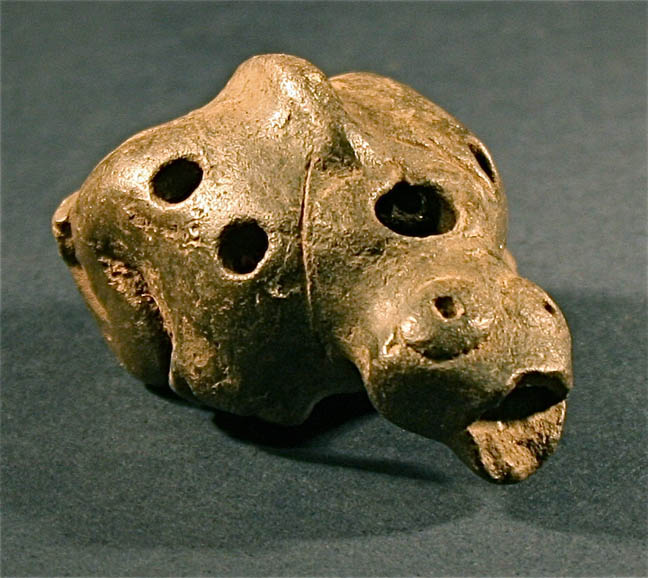

Title: Mayan Antique Artifact Multiple Tone Blowing Folk Whistle
Shipping: $9.00
Artist: N/A
Period: Antiquity
History: N/A
Origin: Central America > El Salvador
Condition: Museum Quality
Item Date: Ancient
Item ID: 2917
This ancient artifact is a whistle flute crafted in the form of an animal and made from natural clay. It was traditionally used during local folk festivities in its time. Whistles like this served as both functional folk tools and toys, often fashioned from pottery. This particular whistle is shaped like an old-world animal and made of brown-gray clay. It features five recorder-style holes on its back, allowing it to produce a variety of tones. We are offering this remarkable antique pottery pocket whistle, a unique collectible from a bygone era. Pocket whistles have been cherished across centuries for their dual purpose as musical instruments and toys. This sounding toy not only provided children with visual delight but also captivated them with its high-pitched, multi-tonal sounds. The whistle includes sound holes on both the left and right sides, enabling it to produce louder and more pleasant tones compared to ordinary whistles. Artifacts like these whistle tools are often unearthed from buried sites around the world, offering a glimpse into ancient traditions and craftsmanship. The Mayan multiple-tone blowing whistle is a fascinating artifact that provides a glimpse into the ancient cultures of Mesoamerica. These folk whistles, often fashioned from pottery or clay, were commonly used during ritualistic ceremonies and local festivities. Crafted by skilled artisans, these whistles were designed not only for functional use but also as artistic expressions. The Mayans, known for their intricate craftsmanship, often incorporated animal forms, spiritual symbols, or natural elements into their designs. These whistles, with their multiple tone holes, were capable of producing a variety of sounds, adding a layer of complexity and beauty to their cultural practices. The use of these whistles was widespread, with evidence of their presence found across different regions of the ancient Mayan civilization. They were used as tools for communication, musical instruments, and toys for children. The high-pitched tones produced by these instruments were thought to have symbolic significance, perhaps representing calls to deities or enhancing the ceremonial atmosphere. As artifacts, Mayan whistles are highly valued today as cultural relics. Their discovery offers insights into the daily lives and spiritual practices of the ancient Maya people. Scattered throughout Mesoamerica, many of these whistles are unearthed during archaeological digs, preserving the legacy of an advanced civilization.
The Mayan civilization, one of the most advanced and influential cultures in ancient Mesoamerica, originated around 2000 BCE in what is now southeastern Mexico, Guatemala, Belize, and parts of Honduras and El Salvador. Known for their impressive achievements in architecture, mathematics, astronomy, and writing, the Maya developed a sophisticated society with complex urban centers, such as Tikal, Palenque, and Copán. Their calendar systems and hieroglyphic writing are still revered for their precision and detail. Integral to Mayan culture were rituals and ceremonies, often tied to the cycles of nature, which included the use of music and instruments like the pottery whistle. These whistles, commonly shaped in animal forms, played a role in both everyday life and ceremonial practices. Capable of producing multiple tones, they were used in festivals, religious rituals, and as toys, reflecting the Mayan’s deep connection to the spiritual and natural worlds around them. The survival of these artifacts offers a window into the cultural richness and creativity of the ancient Maya.
Link: http://en.wikipedia.org/wiki/Whistle
A simple whistle is a woodwind instrument which produces sound from a stream of forced air. The whistle has its roots dating back to ancient China. Chinese night watchmen used to blow into the tops of acorns in order to alert the towns of invading Mongolians. In ancient Egypt two blades of the papyrus plant along the Nile river were held together in between the palms. By blowing into the palms the papyrus leaves would make a loud vibrant sound. The whistle works by causing the smooth flow of air to be split by a narrow blade, sometimes called a fipple, creating a turbulent vortex which causes the air to vibrate. By attaching a resonant chamber to the basic whistle, it may be tuned to a particular note and made louder. The length of the chamber typically defines the resonance frequency. A whistle may also contain a small light ball, usually called the pea, which rattles around inside, creating a chaotic vibrato effect that intensifies the sound. Japanese bird whistles use several small balls and are half filled with water in order to reproduce the sound of a bird song.